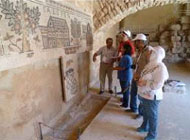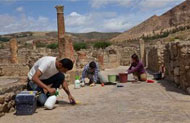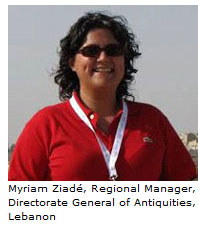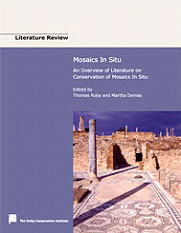 |
 |
 |
 |
 |
 |
 |
 |
 |
 |
 |
 |
 |
 |
 |
 |
 |
 |
 |
 |
Fall 2012 |
 |
|
 |
 |
 |
C U R R E N T A C T I V I T I E S |
 |
 |
 |
 |
 |
 |
 |
 |
 |
 |
 |
 |
 |
Saving Mosaics in Museums of the Southern and Eastern Mediterranean |
 |
 |
 |
 |
 |
 |
 |
 |
 |
 |
 |

|
 |
From June 10 to 28, nineteen professionals from Algeria, Cyprus, Egypt, Jordan, Lebanon, Libya, Morocco, Tunisia, and Turkey gathered in Amman, Jordan, for a three-week course on the conservation and presentation of lifted mosaics in museums—Saving Mosaics in Museums of the Southern and Eastern Mediterranean. Organized by ICCROM, this MOSAIKON training program was supported by a grant from the Getty Foundation and received the patronage of HRH Princess Sumaya bint El Hassan, vice chairman of the board of trustees of the Jordan Museum, Jordan.
|
 |

|
|
Participants and instructor discussing themes, techniques, conditions, and display options during a group documentation exercise at the open air exhibit at Madaba, Jordan. Photo: Gaël de Guichen
|
|
The course, a combination of lectures, group discussions, and group work, covered topics ranging from proper storage and current conservation practices to the history and meaning of mosaics and international legal frameworks, allowing participants to share information about their own collections, and to apply newly learned skills. During the last week of the course, participants and instructors designed and mounted a small exhibition titled Mosaics, Our Common Heritage, which remains on display at the Jordan Museum for school visits. At the end of the program, seven directors from museums and departments of antiquities across the region convened for two days of discussions on display and storage issues at archaeological museums.
|
|
 |
 |
 |
 |
 |
 |
 |
 |
 |
 |
 |
 |
 |
Bulla Regia Mosaic Conservation Project |
 |
 |
 |
 |
 |
 |
 |
 |
 |
 |
 |

|
 |
The MOSAIKON Bulla Regia Mosaic Conservation project began in 2011, developing from ten years of in situ mosaic technician training in Tunisia by the Getty Conservation Institute (GCI) and its partner, the Institut National du Patrimoine of Tunisia (INP). GCI-trained mosaic technicians are currently employed at the archaeological site of Bulla Regia, Tunisia, where they are responsible for ongoing maintenance of the site's mosaics.
|
 |

|
|
Recent GCI-trained INP mosaic technician working with GCI staff and consultant to conserve the mosaics of the Maison de la Chasse. Photo: Scott S. Warren © J. Paul Getty Trust
|
|
In addition to implementing a model comprehensive conservation program at a house on the site, another aim of the Bulla Regia project is to develop a conservation plan for the site's approximately 300 excavated mosaics. Given the site's limited resources, both human and financial, the survival of hundreds of mosaics depends on developing and implementing a prioritized action plan that will provide a much-needed management tool for Bulla Regia. As a first step in the conservation planning process, the team developed a rapid survey form and began collecting data on each mosaic's condition, significance, and degree of exposure. During the most recent project campaign in June, over half of the mosaics were surveyed and photographed; the remainder will be surveyed during the next campaign this fall.
|
|
 |
 |
 |
 |
 |
 |
 |
 |
 |
 |
A L U M N I N E W S |
 |
 |
 |
 |
 |
 |
 |
 |
 |
 |
 |

|
 |
 As an archaeologist and a regional manager at the Directorate General of Antiquities in Lebanon, Myriam Ziadé is responsible for a number of sites and storage facilities that contain mosaics. She shared the following thoughts: As an archaeologist and a regional manager at the Directorate General of Antiquities in Lebanon, Myriam Ziadé is responsible for a number of sites and storage facilities that contain mosaics. She shared the following thoughts:
"Attending two MOSAIKON courses [Conservation and Management of Mosaics at Archaeological Sites, and Saving Mosaics in Museums of the Southern and Eastern Mediterranean] has been interesting and rewarding. Bringing together participants from across the Mediterranean region not only allowed people to share their personal experiences and different approaches to conservation of cultural heritage, but to also discuss concerns about its fragility and deterioration. The interactive teaching methods fostered open communication, and the fieldwork added special value to the courses. I was also impressed by the quality of the technical guidance provided by instructors who freely shared their knowledge, passion, and enthusiasm.
"Participating in these courses gave me the knowledge, motivation, and support I needed to immediately start applying what I learned as soon as I got back to Lebanon—including how to make the best decision for the preservation of a mosaic pavement and the different steps for a good conservation program, from documentation through to presentation, both on sites and in museums. Training projects prepared by the participants in their own countries were followed constantly by the instructors, who gave advice throughout the process.
"Looking ahead, I'm trying to move forward in the most efficient way with all the experience I've gained. I truly appreciate the confidence I gained during the courses and I'm thrilled to be part of the mosaic network we created. I take this opportunity to express my gratitude to the instructors and organizers for their help, patience, commitment, and support."
If you have participated in a MOSAIKON course, we encourage you to share your experiences with your colleagues by sending us a description of a mosaics-related project you are working on or a report on your other professional activities since participating in a MOSAIKON course. Please send your text and photographs to: MOSAIKONnews@getty.edu.
|
 |
 |
 |
P R O J E C T U P D A T E S |
 |
 |
 |
 |
 |
 |
 |
 |
 |
 |
 |
 |
 |
Course for Technicians of Lifted Mosaics |
 |
 |
 |
 |
 |
 |
 |
 |
 |
 |
 |

|
 |
MOSAIKON's pilot training course for Syrian conservation technicians, developed and implemented by at Centro di Conservazione Archaeologica (CCA) with support from the Getty Foundation, completed its second training module in July 2012. This fall, CCA will host six technicians from Jordan and Tunisia at its headquarters in Belmonte, Italy, outside of Rome. During the course, participants will analyze ancient materials and techniques, learn documentation methods, discuss long-term maintenance strategies of lifted mosaics, and work with instructors to conserve a third-century Roman mosaic.
|
|
 |
 |
 |
 |
 |
 |
 |
 |
 |
 |
 |
 |
 |
Course for Technicians of In Situ Mosaics |
 |
 |
 |
 |
 |
 |
 |
 |
 |
 |
 |

|
 |
MOSAIKON's Regional Course for Technicians of In Situ Mosaics, led by the Getty Conservation Institute, began in April 2012 in El Jem, Tunisia, with twelve participants from Morocco, Algeria, Tunisia, and Libya. The first module covered written, graphic and photographic documentation of mosaics, after which the trainees carried out field exercises at their sites. Course instructors have conducted site visits to Morocco and Tunisia to assist and follow the trainees' progress before the next module on the stabilization of in situ mosaics begins in November 2012.
|
|
 |
 |
 |
P U B L I C A T I O N S & R E S O U R C E S |
 |
 |
 |
 |
 |
 |
 |
 |
 |
 |
 |
 |
 |
Mosaics In Situ: An Overview of Literature on Conservation of Mosaics In Situ |
 |
 |
 |
 |
 |
 |
 |
 |
 |
 |
 |

|
 |
This literature review, conducted by the Getty Conservation Institute on the conservation of mosaics in situ, brings forth principal practices and trends in mosaic conservation as reflected in published works through 2007. The literature review, to be published in phases, will include chapters in six subject areas:
- Inventories and Official Corpora (forthcoming)
- Causes of Deterioration (forthcoming)
- Conservation Treatments and Maintenance (forthcoming)
- Protective Shelters for Archaeological Sites (available)
- Reburial and Protective Covering of Mosaics (available)
- Training and Awareness (forthcoming)
|
 |

|
|
Photo: GCI
|
|
All chapters establish the current state of knowledge in their respective subject areas and identify areas in need of further research. Chapters also include the references or annotated bibliography on which they were based.
Mosaics In Situ: An Overview of Literature on Conservation of Mosaics In Situ (112pp., 926KB)
|
|
 |
 |
 |
 |
 |
 |
 |
 |
 |
 |
 |
 |
 |
 |
 |
 |
 |
 |
 |
 |
 |
 |
 |
 |
CONTACT US
The Getty Conservation Institute
1200 Getty Center Drive, Suite 700
Los Angeles, CA 90049-1684
USA
Tel.: (310) 440-7325
Fax: (310) 440-7702
www.getty.edu/conservation
MOSAIKONnews@getty.edu
Press inquiries: mabraham@getty.edu
About MOSAIKON e-Bulletin
MOSAIKON e-Bulletin is published electronically twice a year to keep partners and participants up to date with MOSAIKON programs and activities.
You are subscribed as %%emailaddr%%.
Subscribe to MOSAIKON e-Bulletin | Unsubscribe here
Find out more about MOSAIKON, or any of the four partner institutions: the Getty Conservation Institute, the Getty Foundation, ICCM, and ICCROM.
|
 |
 |
 |
 |
 |
 |
 |
 |
 |
 |
 |
 |
 |
|
 |
 |
 |
 |
 |
 |
 |
 |
 |
 |
 |
 |
 |
Banner image: Roman mosaic design at El Jem, Tunisia
C O P Y R I G H T © 2012 J. Paul Getty Trust | Privacy Policy |
 |
 |
 |
 |
 |
 |
 |
 |
 |
 |
 |
 |
 |
 |
 |
 |
|